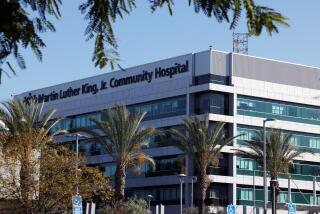Emergency Room Fills 2-Year Gap : First One Since ’87 Opens in Century City; Will Serve 100,000
- Share via
Bucking the trend, Century City Hospital has opened an emergency room, not closed one--the first to open in Los Angeles County in two years.
The new emergency room brings to 93 the number in the county licensed by the state to receive paramedic and ambulance traffic--one fewer than the region had at the beginning of 1989.
Officially opened Monday at a ceremony that included quiche and comedians, the facility offers 24-hour emergency services to an estimated 100,000 people in the area.
‘Dream Emergency Room’
Until now, the closest emergency rooms were at Cedars-Sinai Medical Center in West Los Angeles, UCLA Medical Center in Westwood and Beverly Hills Medical Center. Even people who regularly visit the 195-bed hospital for other reasons had to seek emergency care elsewhere.
“We have everything you would want if you were able to build a dream emergency room,” said James Pagano, medical director for emergency services at Century City Hospital.
The staff was involved in planning the facility, Pagano said, and recommended such features as placing the nurses’ station where the nurses could watch both the door used by incoming paramedics and patients and the monitoring equipment at the beds reserved for the critically ill. The emergency room will be staffed by nine full-time physicians, he said.
The 4,400-square-foot facility cost $1.5 million, hospital Executive Director Joel Bergenfeld said. Century City is a private, for-profit hospital, owned by National Medical Enterprises of Los Angeles.
As Pagano pointed out, the new emergency room is not a trauma center; it lacks the in-house surgeon and anesthesiologist that are among the requirements for licensing as a trauma center. Nor is the opening of an emergency room in a private hospital in affluent Century City expected to be more than a Band-Aid on the county’s faltering emergency care system.
Numbers Have Dwindled
Barbara Pavey, an official with the county’s emergency medical services agency, said the number of emergency rooms in the county has slipped to 93 from 100 since 1987. Only 13 of the 23 trauma centers linked in 1983 remain in operation. Pavey said she doubted that the Century City facility will be “a high-impact ER” as would a new facility in Inglewood or another under-serviced area of the city.
But Century City Hospital officials and observers agree that the facility will at least provide paramedics with an additional option on those increasingly common occasions when busy emergency rooms are “on diversion,” or temporarily closed to them.
At such times, paramedics often have to drive far longer than the requisite 10 minutes from the pickup point, making several stops before they find an emergency room that will accept an ill or injured individual.
“It just gives one more place for paramedics to go if the midtown hospitals are on diversion,” said Kathleen Belkham of the Hospital Council of Southern California.
Bergenfeld said the new emergency room will probably receive three or four ambulance transports a day.
Century City Hospital staff carefully studied the demographics of health care in the area before opening the facility, he said.
Most emergency-room closings are attributed to economics: The facilities, which are required as a condition of their licensing to treat anyone who walks through the door, say they cannot afford to care for growing numbers of uninsured, indigent patients.
But Century City Hospital believes that it can make a go of it, in part, because it expects the majority of its clients to be insured or able to pay. Bergenfeld pointed out that a good emergency-room experience can turn a single-occasion patient into a regular client of a particular hospital. “If we didn’t think this would be a profitable operation, we wouldn’t have proceeded,” he said.
The emergency room is still a gamble, Bergenfeld said. More emergency room and trauma closing centers in Los Angeles could alter the new facility’s patient population and its economic viability. “There are a lot of factors that are completely and totally out of our control,” he said.
But hospital staff are confident enough about the facility’s chances for profitability to laugh about it. At Monday’s ribbon-cutting ceremony, which included the inevitable speech-making and mini-quiches on the brunch buffet, the Groundlings improvised Westside hospital comedy.
“Isn’t this a bank?” asked a comic playing a confused patient. “No, it isn’t a bank per se,” the comedy doctor answered.
More to Read
Sign up for Essential California
The most important California stories and recommendations in your inbox every morning.
You may occasionally receive promotional content from the Los Angeles Times.













